Application of Morrison Cloud Microphysics Scheme in GRAPES_Meso Model and the Sensitivity Study on CCN’s Impacts on Cloud Radiation
Abstract
:1. Introduction
2. Model and Scheme
2.1. GRAPES_Meso
2.2. Morrison Cloud Microphysical Scheme
2.3. Experiments Design
3. Model Evaluation
4. Study Results and Discussions
4.1. The CCN Impacts on the Mass Mixing Ratio of Hydrometeors
4.2. CCN Impacts on Modeled Rc, CLWP, and COD
4.3. CCN Impacts on Cloud Radiation Forcing
5. Summary and Conclusions
Supplementary Materials
Author Contributions
Funding
Institutional Review Board Statement
Informed Consent Statement
Data Availability Statement
Acknowledgments
Conflicts of Interest
References
- Stephens, G.L. Cloud feedbacks in the climate system: A critical review. J. Clim. 2005, 18, 237–273. [Google Scholar] [CrossRef] [Green Version]
- Duan, J.; Liu, Y. Trends of cloud optical depth and cloud effective radius variation in China. J. Meteorol. Sci. Technol. 2011, 39, 408–416. (In Chinese) [Google Scholar]
- Ackerman, A.S.; Toon, O.B.; Taylor, J.P.; Johnson, D.W.; Hobbs, P.V.; Ferek, R.J. Effects of aerosols on cloud albedo: Evaluation of Twomey’s parameterization of cloud susceptibility using measurements of ship tracks. J. Atmos. Sci. 2000, 57, 2684–2695. [Google Scholar] [CrossRef] [Green Version]
- Yin, J.; Wang, D.; Zhai, G. Long-term in situ measurements of the cloud-precipitation microphysical properties over East Asia. J. Atmos. Res. 2011, 102, 206–217. [Google Scholar] [CrossRef]
- Clark, T.L. Numerical modeling of the dynamics and microphysics of warm cumulus convection. J. Atmos. Sci. 1973, 30, 857–878. [Google Scholar] [CrossRef]
- Takahashi, T. Tropical showers in an axisymmetric cloud model. J. Atmos. Sci. 1975, 32, 1318–1330. [Google Scholar] [CrossRef] [Green Version]
- Garvert, M.F.; Woods, C.P.; Colle, B.A.; Mass, C.F.; Hobbs, P.V.; Stoelinga, M.T.; Wolfe, J.B. The 13-14 December 2001 IMPROVE-2 Event. Part II: Comparisons of MM5 model simulations of clouds and precipitation with observations. J. Atmos. Sci. 2005, 62, 3520–3534. [Google Scholar] [CrossRef]
- Sarkadi, N.; Geresdi, I.; Thompson, G. Numerical simulation of precipitation formation in the case orographically induced convective cloud: Comparison of the results of bin and bulk microphysical schemes. J. Atmos. Res. 2016, 180, 241–261. [Google Scholar] [CrossRef]
- Hall, W.D. A detailed microphysical model within a two-dimensional dynamic framework: Model description and preliminary results. J. Atmos. Sci. 1980, 37, 2486–2507. [Google Scholar] [CrossRef]
- Khain, A.P.; Sednev, I. Simulation of precipitation formation in the eastern Mediterranean coastal zone using a spectral microphysics cloud ensemble model. Atmos. Res. 1996, 43, 77–110. [Google Scholar] [CrossRef]
- Lin, Y.L.; Farley, R.D.; Orville, H.D. Bulk parameterization of the snow field in a cloud model. J. Appl. Meteorol. Sci. 1983, 22, 1065–1092. (In Chinese) [Google Scholar] [CrossRef] [Green Version]
- Mitchell, D.L. A model predicting the evolution of ice particle size spectra and radiative properties of cirrus clouds. Part I: Microphysics. J. Atmos. Sci. 1994, 51, 797–816. [Google Scholar] [CrossRef] [Green Version]
- Frick, C.; Seifert, A.; Wernli, H. A bulk parameterization of melting snowflakes with explicit liquid water fraction for the COSMO model. Geosci. Model Dev. 2013, 6, 1925–1939. [Google Scholar] [CrossRef] [Green Version]
- Cotton, W.R.; Tripoli, G.J.; Rauber, R.M.; Mulvihill, E.A. Numerical simulation of the effects of varying ice crystal nucleation rates and aggregation processes on orographic snowfall. J. Climate Appl. Meteorol. 1986, 25, 1658–1680. [Google Scholar] [CrossRef] [Green Version]
- Reisin, T.; Levin, Z.; Tzivion, S. Rain production in convective clouds as simulated in an axisymmetric model with detailed microphysics. Part, I. Description of the model. J. Atmos. Sci. 1996, 53, 497–519. [Google Scholar] [CrossRef] [Green Version]
- Milbrandt, J.A.; Yau, M.K.; Mailhot, J.; Bélair, S. Simulation of an Orographic Precipitation Event during IMPROVE-2. Part I: Evaluation of the Control Run Using a Triple-Moment Bulk Microphysics Scheme. Mon. Weather Rev. 2008, 136, 3873–3893. [Google Scholar] [CrossRef]
- Ferrier, B.S. A double-moment multiple-phase four-class bulk ice scheme, Part 1: Description. J. Atmos. Sci. 1994, 51, 249–280. [Google Scholar] [CrossRef] [Green Version]
- Gao, W.; Zhao, F.; Hu, Z.; Feng, X. A two-moment bulk microphysics coupled with a mesoscale model WRF: Model description and first results. J. Adv. Atmos. Sci. 2011, 28, 1184–1200. [Google Scholar] [CrossRef]
- Zheng, X.; Albrecht, B.; Minnis, P.; Ayers, K.; Jonson, H.H. Observed aerosol and liquid water path relationships in marine stratocumulus. Geophys. Res. Lett. 2010, 37. [Google Scholar] [CrossRef] [Green Version]
- Zhou, C.H.; Gong, S.; Zhang, X.Y.; Liu, H.L.; Xue, M.; Cao, G.L.; An, X.Q.; Che, H.Z.; Zhang, Y.M.; Niu, T. Towards the improvements of simulating the chemical and optical properties of Chinese aerosols using an online coupled model-CUACE/Aero. Tellus B 2012, 64, 18965. [Google Scholar] [CrossRef] [Green Version]
- Wang, Z.L.; Zhang, H.; Lu, P. Improvement of cloud microphysics in the aerosol-climate model BCC_AGCM2.0.1_CUACE/Aero, evaluation against observations, and updated aerosol indirect effect. J. Geophys. Res. Atmos. 2014, 119, 8400–8417. [Google Scholar] [CrossRef]
- Morrison, H.; Curry, J.A.; Khvorostyanov, V.I. A new double-moment microphysics parameterization for application in cloud and climate models, Part I: Description. J. Atmos. Sci. 2005, 62, 1665–1677. [Google Scholar] [CrossRef]
- He, T.; Zhao, F.S. An improved retrieval algorithm of aerosol optical depth. J. Appl. Meteorol. Sci. 2011, 22, 663–672. (In Chinese) [Google Scholar]
- Dong, H.; Xu, H.M.; Luo, Y.L. Effects of cloud condensation nuclei concentration on precipitation in convection permitting simulations of a squall line using WRF model: Sensitivity to cloud microphysical schemes. Chin. J. Atmos. Sci. 2012, 36, 145–169. (In Chinese) [Google Scholar]
- Shen, X.Y.; Mei, H.X.; Wang, W.G.; Huang, W.Y. Numerical simulation of ice-phase processes using a double-moment microphysical scheme and a sensitivity test of ice nuclei concentration. Chin. J. Atmos. Sci. 2015, 39, 83–99. (In Chinese) [Google Scholar]
- Baró, R.; Jiménez-Guerrero, P.; Balzarini, A.; Curci, G.; Forkel, R.; Grell, G.; Hirtl, M.; Honzak, L.; Langer, M.; Pérez, J.L.; et al. 2015: Sensitivity analysis of the microphysics scheme in WRF-Chem contributions to AQMEII phase 2. J. Atmos. Environ. 2015, 115, 620–629. [Google Scholar] [CrossRef]
- Li, G.; Wang, Y.; Zhang, R. Implementation of a two-moment bulk microphysics scheme to the WRF model to investigate aerosol-cloud interaction. J. Geophys. Res. 2008, 113, 1139. [Google Scholar] [CrossRef]
- Morrison, H.; Milbrandt, J.A. Parameterization of cloud microphysics based on the prediction of bulk ice particle properties. Part I: Scheme description and idealized tests. J. Atmos. Sci. 2015, 72, 287–311. [Google Scholar] [CrossRef]
- Thompson, G.; Field, P.R.; Rasmussen, R.M.; Hall, W.D. Explicit forecasts of winter precipitation using an improved bulk microphysics scheme. Part II: Implementation of a new snow parameterization. Mon. Weather Rev. 2008, 136, 5095–5115. [Google Scholar] [CrossRef]
- Thompson, G.; Rasmussen, R.M.; Manning, K. Explicit forecasts of winter precipitation using an improved bulk microphysics scheme. Part I: Description and sensitivity analysis. Mon. Weather Rev. 2004, 132, 519–542. [Google Scholar] [CrossRef] [Green Version]
- Thompson, G.; Eidhammer, T. A study of aerosol impacts on clouds and precipitation development in a large winter cyclone. J. Atmos. Sci. 2014, 71, 3636–3658. [Google Scholar] [CrossRef]
- Heinzeller, D.; Junkermann, W.; Kunstmann, H. Anthropogenic aerosol emissions and rainfall decline in southwestern Australia: Coincidence or causality? J. Clim. 2016, 29, 8471–8493. [Google Scholar] [CrossRef] [Green Version]
- Reshmi Mohan, P.; Srinivas, C.V.; Yesubabu, V.; Baskaran, R.; Venkatraman, B. Simulation of a heavy rainfall event over Chennai in Southeast India using WRF: Sensitivity to microphysics parameterization. Atmos. Res. 2018, 210, 83–99. [Google Scholar] [CrossRef]
- Jiang, H.; Feingold, G. Effect of aerosol on warm convective clouds: Aerosol-cloud-surface flux feedbacks in a new coupled large eddy model. J. Geophys. Res. 2006, 111. [Google Scholar] [CrossRef]
- Ochs, H.T.; Yao, C.S. Moment-conserving techniques for warm cloud microphysical computations. Part I: Numerical techniques. J. Atmos. Sci. 2010, 35, 1947–1958. [Google Scholar] [CrossRef] [Green Version]
- Li, Y.W.; Quan, X.; Zhang, Z.F. Numerical research of CCN concentration and its paramreterization scheme’s influence on a stratiform precipitation process. Trans. Atmos. Sci. 2018, 184, 119–130. (In Chinese) [Google Scholar]
- O’Sullivan, P.B.; Phyty, G.D.; Twomey, L.T. Evaluation of specific stabilizing exercise in the treatment of chronic low back pain with radiologic diagnosis of spondylolysis or spondylolisthesis. Spine 1997, 22, 2959–2967. [Google Scholar] [CrossRef]
- Klaus, W. The Effective Radius in Ice Clouds. J. Clim. 1997, 11, 1793–1802. [Google Scholar]
- Yang, B.Y.; Zhang, H.; Peng, J.; Wang, Z.L.; Jing, X.W. Analysis on Global Distribution Characteristics of Cloud Microphysical and Optical Properties Based on the CloudSat Data. Plateau Weather 2014, 33, 1105–1118. [Google Scholar]
- Chen, D.H.; Shen, X.S. Recent progress on GRAPES research and application. J. Appl. Meteorol. Sci. 2006, 17, 773–777. (In Chinese) [Google Scholar]
- Wu, X.J.; Jin, Z.Y.; Huang, L.P.; Chen, D.H. The software framework and application of GRAPES model. J. Appl. Meteorol. Sci. 2005, 16, 539–546. (In Chinese) [Google Scholar]
- Chen, D.H.; Xue, J.S.; Yang, X.S.; Zhang, H.L.; Shen, X.S.; Hu, J.L.; Wang, Y.; Ji, L.R.; Chen, J.B. New generation of multi-scale NWP system (GRAPES): General scientific design. Chin. Sci. Bull. 2008, 53, 3433–3445. (In Chinese) [Google Scholar] [CrossRef] [Green Version]
- Xu, G.Q.; Chen, D.H.; Xue, J.S.; Sun, J.; Shen, X.S.; Shen, Y.F.; Hung, L.P.; Wu, X.J.; Zhang, H.L.; Wang, S.Y. The program structure designing and optimizing tests of GRAPES physics. Chin. Sci. Bull. 2008, 53, 3470–3476. [Google Scholar] [CrossRef] [Green Version]
- Zhang, R.H.; Shen, X.S. On the development of the GRAPES—A new generation of the national operational NWP system in China. Chin. Sci. Bull. 2008, 53, 3429–3432. [Google Scholar] [CrossRef] [Green Version]
- Zheng, Z.Z.; Zhang, W.C.; Xu, J.W.; Zhao, L.N.; Chen, J.; Yan, Z.W. Numerical simulation and evaluation of a new hydrological model coupled with GRAPES. J. Meteorol. Res. 2012, 26, 653–663. [Google Scholar] [CrossRef]
- Zhou, C.H.; Shen, X.J.; Liu, Z.R.; Zhang, Y.M.; Xin, J.Y. Simulating aerosol size distribution and mass concentration with simultaneous nucleation, condensation/coagulation, and deposition with the GRAPES–CUACE. J. Meteorol. Res. 2018, 32, 265–278. [Google Scholar] [CrossRef]
- Wang, H.; Xue, M.; Zhang, X.Y.; Liu, H.L.; Zhou, C.H.; Tan, S.C.; Che, H.Z.; Chen, B.; Li, T. Mesoscale modeling study of the interactions between aerosols and PBL meteorology during a haze episode in Jing–Jin–Ji (China) and its nearby surrounding region—Part 1: Aerosol distributions and meteorological features. Atmos. Chem. Phys. 2015, 15, 3257–3275. [Google Scholar] [CrossRef] [Green Version]
- Nie, H.H.; Liu, Q.J.; Ma, Z.S. Simulation and analysis of heavy precipitation using cloud microphysical scheme coupled with high-resolution GRAPES model. Meteorol. Mon. 2016, 42, 1431–1444. (In Chinese) [Google Scholar]
- Yang, X.; Hu, J.; Chen, D.; Zhang, H.; Shen, X.; Chen, J.; Ji, L. Verification of GRAPES unified global and regional numerical weather prediction model dynamic core. Chin. Sci. Bull. 2008, 53, 3458–3464. [Google Scholar] [CrossRef] [Green Version]
- Rosenkranz, P.W. Rapid radiative transfer model for AMSU/HSB channels. IEEE Trans. Geosci. Remote Sens. 2003, 41, 362–368. [Google Scholar] [CrossRef]
- Mielikainen, J.; Huang, B.; Huang, H.L.A.; Goldberg, M.D. GPU acceleration of the updated Goddard shortwave radiation scheme in the weather research and forecasting (WRF) Model. IEEE J. Sel. Top. Appl. Earth Obs. Remote Sens. 2012, 5, 555–562. [Google Scholar] [CrossRef]
- Johansson, C.; Smedman, A.S.; Högström, U.; Brasseur, J.G.; Khanna, S. Critical test of the validity of Monin-Obukhov similarity during convective conditions. J. Atmos. Sci. 2011, 58, 1549–1566. [Google Scholar] [CrossRef]
- Ek, M.B. Implementation of Noah land surface model advances in the national centers for environmental prediction operational mesoscale Eta model. J. Geophys. Res. Atmos. 2003, 108, 8851. [Google Scholar] [CrossRef]
- Janjić, Z.I. Comments on “Development and evaluation of a convection scheme for use in climate models”. J. Atmos. Sci. 2000, 57, 3686. [Google Scholar] [CrossRef]
- Hong, S.Y.; Pan, H.L. Nonlocal boundary layer vertical diffusion in a medium-range forecast Model. J. Mon. Weather Rev. 1996, 124, 2322. [Google Scholar] [CrossRef] [Green Version]
- Morrison, H.; Thompson, G.; Tatarskii, V. Impact of cloud microphysics on the development of trailing stratiform precipitation in a simulated squall line: Comparison of one- and two-moment schemes. Mon. Weather Rev. 2009, 137, 991–1007. [Google Scholar] [CrossRef] [Green Version]
- Morrison, H. Modeling clouds observed at SHEBA using a bulk microphysics parameterization implemented into a single-column model. J. Geophys. Res. 2003, 108, 4255. [Google Scholar] [CrossRef]
- Morrison, H.; Pinto, J.O. Mesoscale Modeling of Springtime Arctic Mixed-Phase Stratiform Clouds Using a New Two-Moment Bulk Microphysics Scheme. J. Atmos. Sci. 2005, 62, 3683–3704. [Google Scholar] [CrossRef]
- Zhang, M.; Wang, H.; Zhang, X.; Peng, Y.; Che, H.Z. 2018: Applying the WRF Double-Moment Six-Class microphysics scheme in the GRAPES_Meso model: A case study. J. Meteorol. Res. 2018, 32, 246–264. [Google Scholar] [CrossRef]
- Lu, G.X.; Guo, X.L. Distribution and origin of aerosol and its transform relationship with CCN derived from the spring multi-aircraft measurements of Beijing cloud experiment (BCE). Chin. Sci. Bull. 2012, 57, 2460–2469. [Google Scholar] [CrossRef] [Green Version]
- Li, J.X.; Yin, Y.; Ren, G.; Yuan, L.; Li, P.R.; Shen, D.D. Observational study of the spatial-temporal distribution of cloud condensation nuclei in Shanxi Province, China. China Environ. Sci. 2015, 8, 23–33. (In Chinese) [Google Scholar]
- Shi, L.X.; Duan, Y. Observations of cloud condensation nuclei in North China. Acta Meteorol. Sin. 2007, 65, 644–652. (In Chinese) [Google Scholar]
- Feng, Q.J.; Li, P.R.; Fan, M.Y.; Hou, T.J. Observational analysis of cloud condensation nuclei in some regions of North China. Trans. Atmos. Sci. 2012, 35, 533–540. (In Chinese) [Google Scholar]
- Lee, S.S.; Donner, L.J.; Phillips, V.T.J. Cloud and aerosol effects on radiation in deep convective clouds: Comparison with warm stratiform clouds. Atmos. Chem. Phys. 2008, 8, 15291–15341. [Google Scholar]
- Ji, Q.; Shaw, G. On supersaturation spectrum and size distributions of cloud condensation nuclei. Geophys. Res. Lett. 1998, 25, 1903–1906. [Google Scholar] [CrossRef]
- Fitzgerald, J.W. Dependence of the supersaturation spectrum of ccn on aerosol size distribution and composition. J. Atmos. Sci. 2010, 30, 628–634. [Google Scholar] [CrossRef] [Green Version]
- Spice, A.; Johnson, D.W.; Brown, P.R.A.; Darlison, A.G.; Saunders, C.P.R. Primary ice nucleation in orographic cirrus clouds: A numerical simulation of the microphysics. Q. J. R. Meteorol. Soc. 1999, 125, 1637–1667. [Google Scholar] [CrossRef]
- Wang, J.; Lee, Y.N.; Daum, P.H.; Jayne, J.; Alexander, M.L. Effects of aerosol organics on cloud condensation nucleus (CCN) concentration and first indirect aerosol effect. Atmos. Chem. Phys. 2008, 8, 6325–6339. [Google Scholar] [CrossRef] [Green Version]
- Deng, Z.Z.; Zhao, C.S.; Zhang, Q.; Huang, M.Y.; Ma, X.C. Statistical analysis of microphysical properties and the parameterization of effective radius of warm clouds in Beijing area. Atmos. Res. 2009, 93, 888–896. [Google Scholar] [CrossRef]
- Painemal, D.; Zuidema, P. Microphysical variability in southeast Pacific Stratocumulus clouds: Synoptic conditions and radiative response. Atmos. Chem. Phys. 2010, 10, 6255–6269. [Google Scholar] [CrossRef] [Green Version]
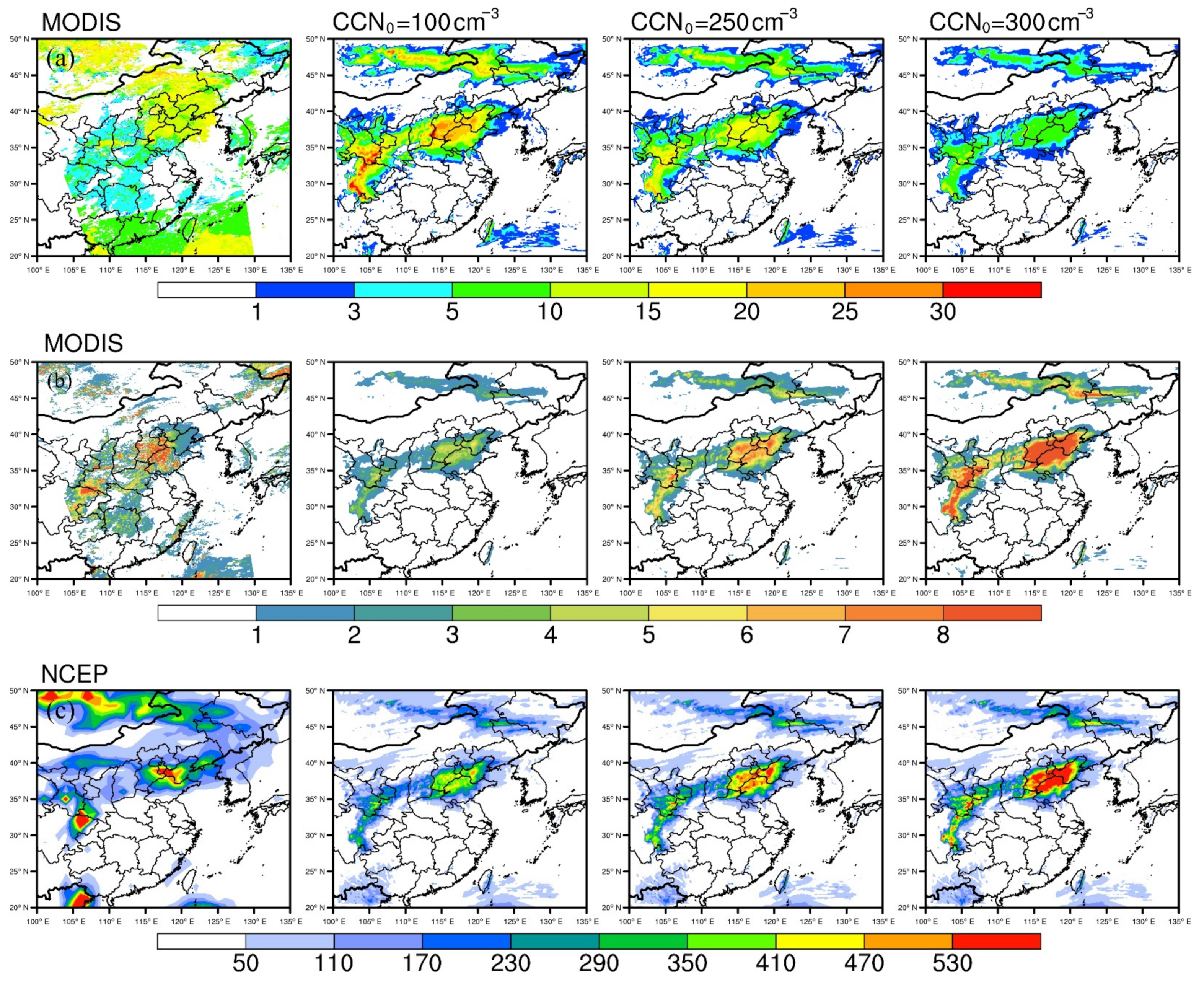



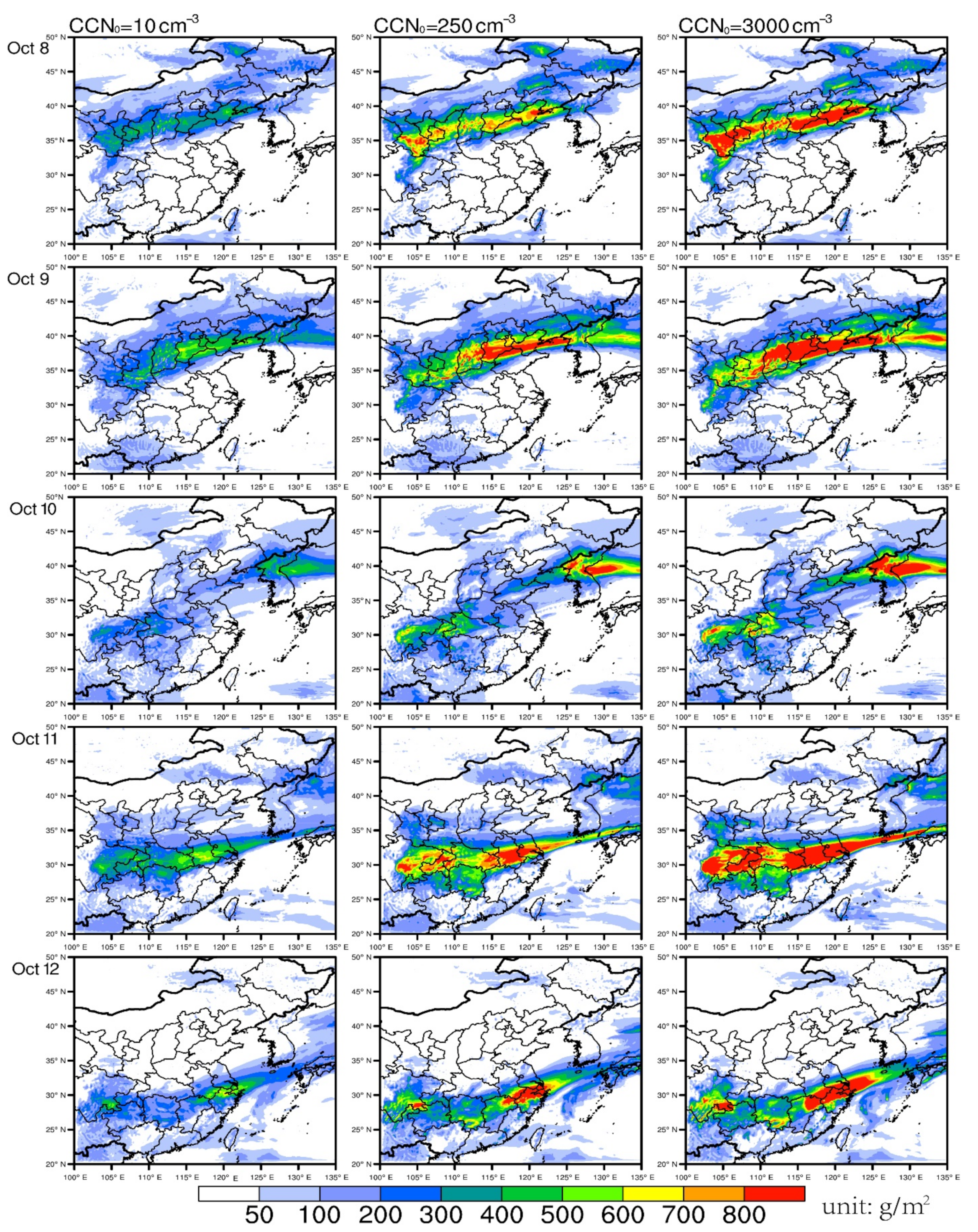
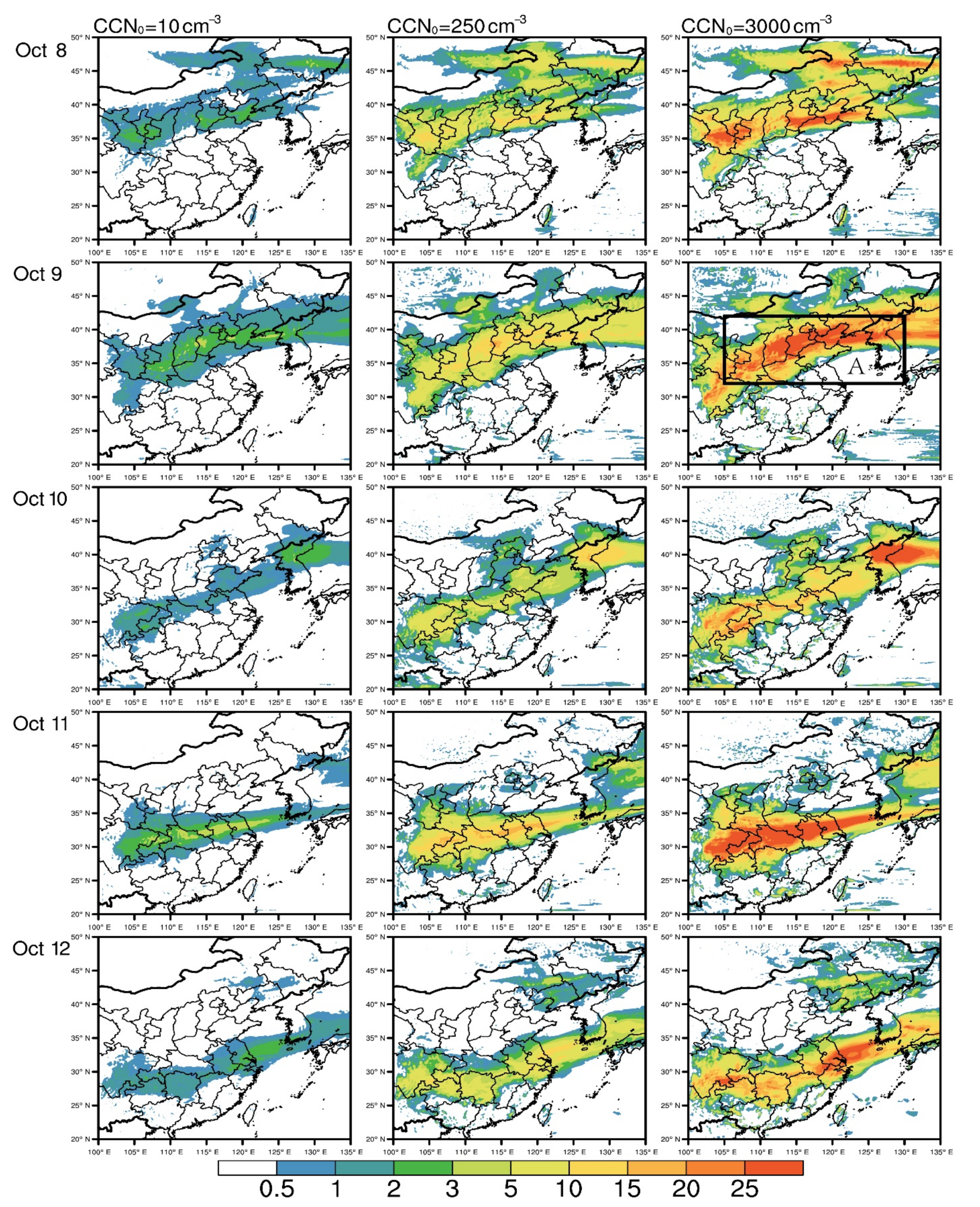
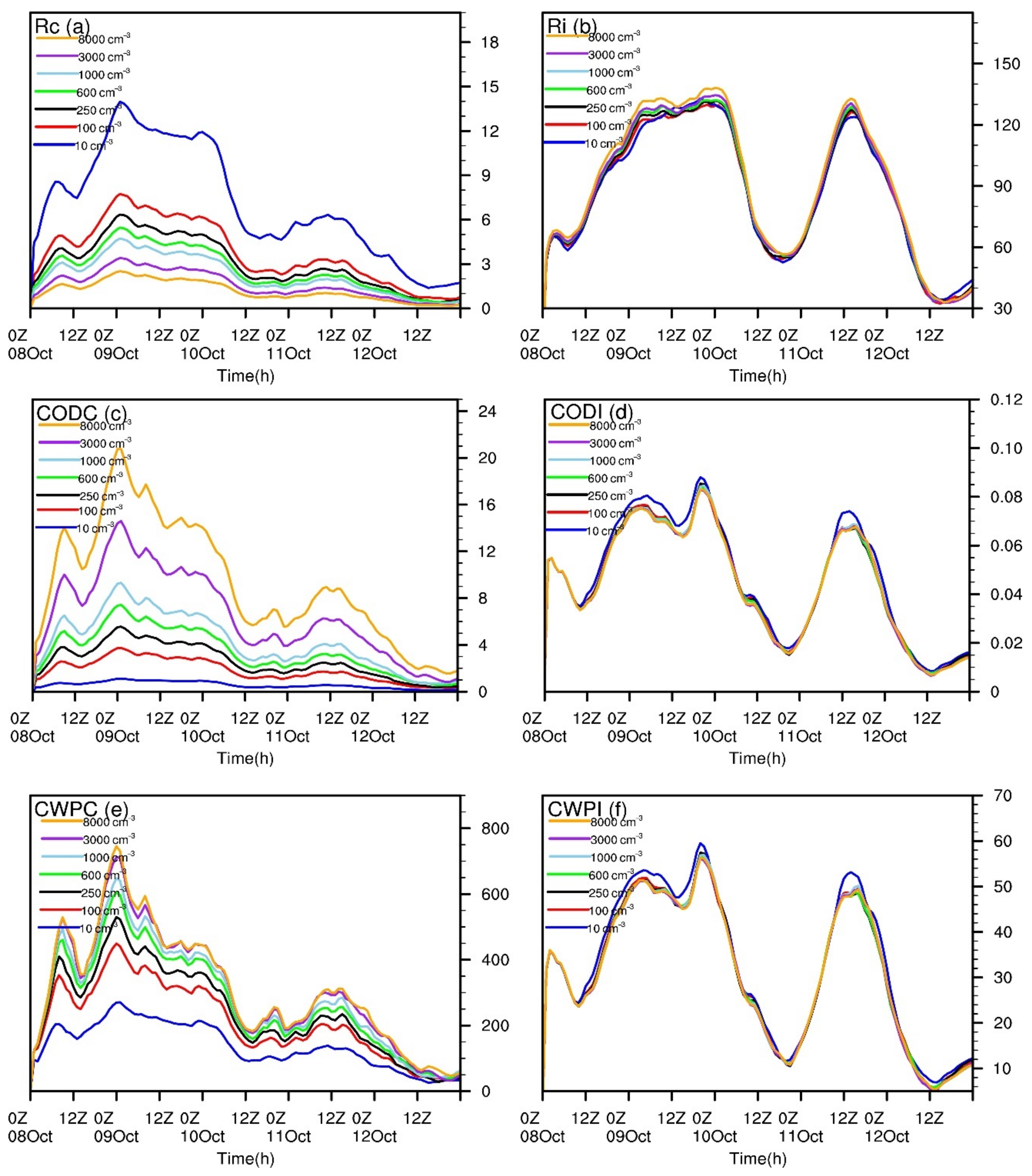
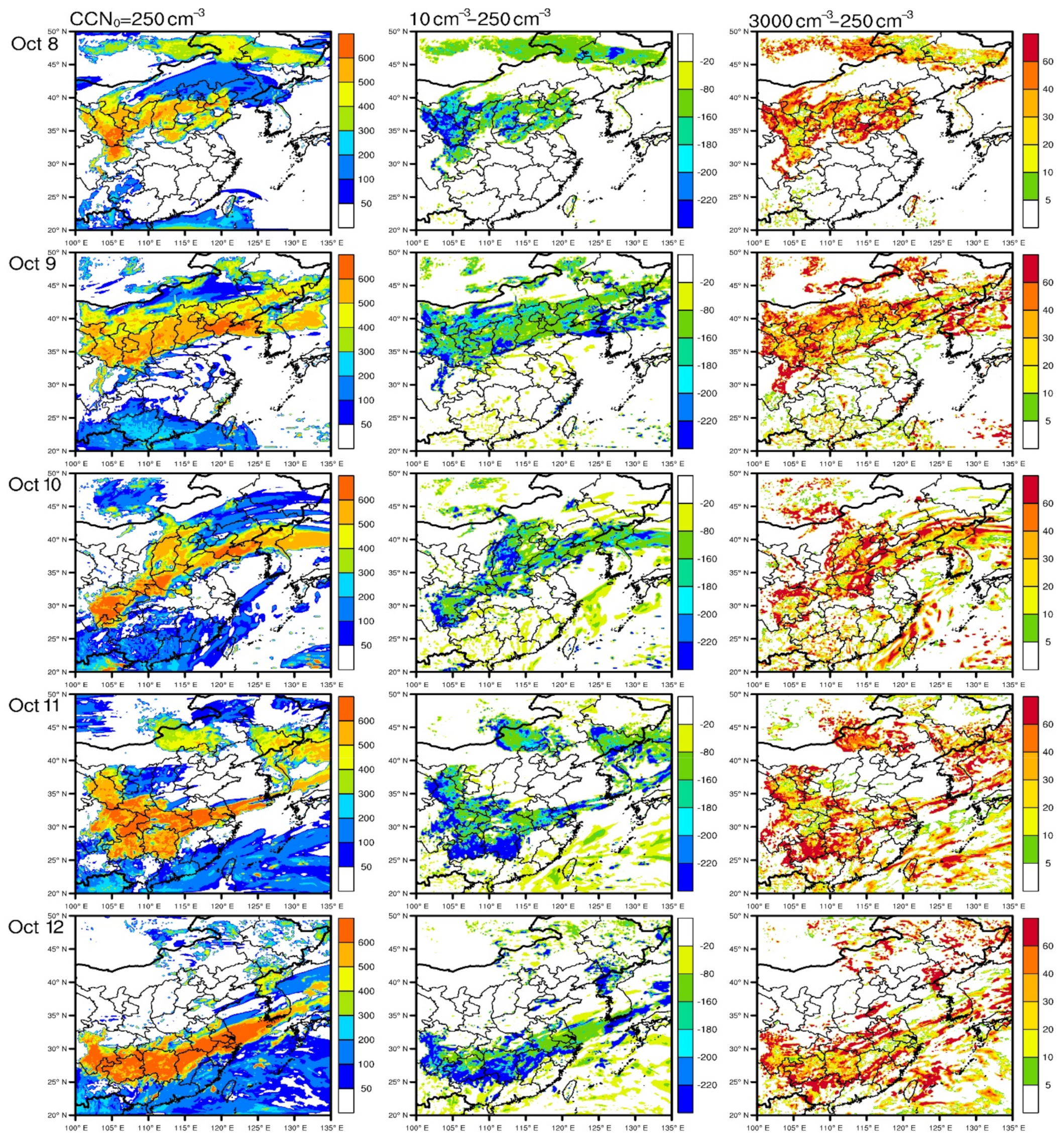
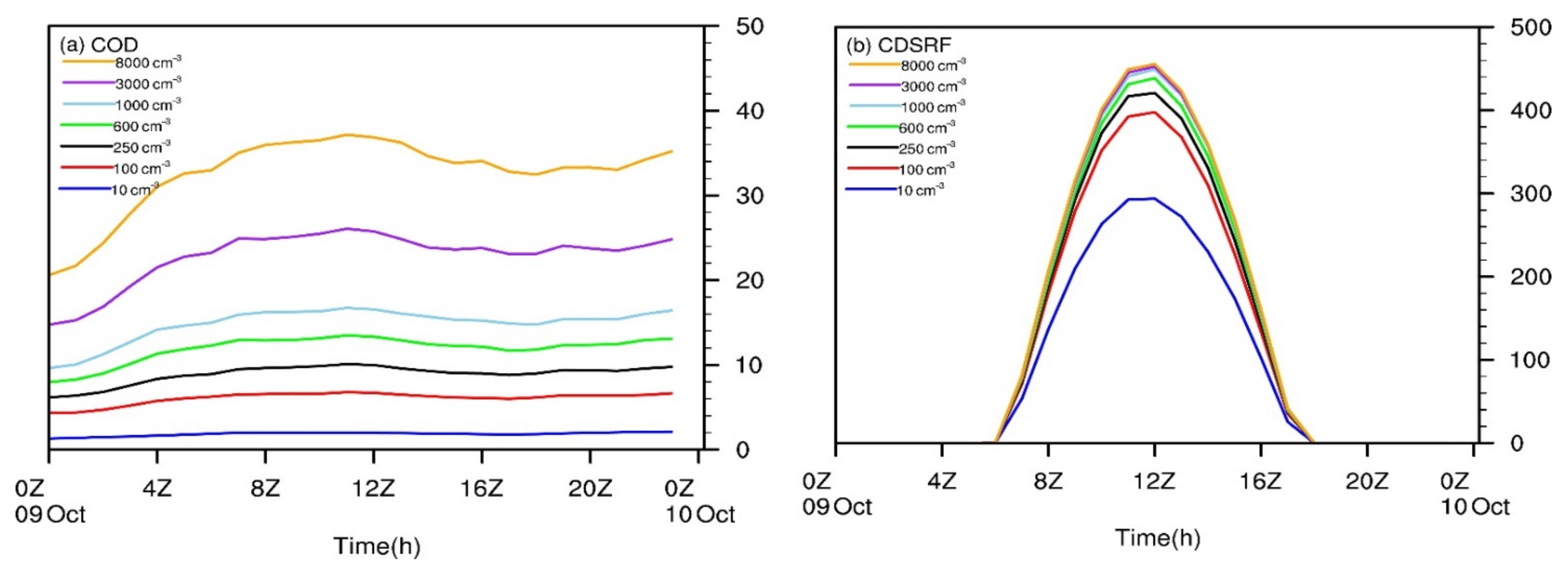
| Notation | Description |
|---|---|
| CCN | cloud condensation nuclei |
| Rc | effective radius of cloud water |
| Ri | effective radius of cloud ice |
| qc | mixing ratio of cloud water |
| qr | mixing ratio of cloud raindrops |
| qs | mixing ratio of cloud snow |
| qi | mixing ratio of cloud ice |
| qg | mixing ratio of cloud graupel |
| nc | number concentration of cloud water |
| nr | number concentration of raindrops |
| ns | number concentration of snow |
| ni | number concentration of ice |
| ng | number concentration of graupel |
| CLWP | cloud liquid water path |
| COD | cloud optical depth |
| CWPC | cloud liquid water path of cloud water |
| CWPI | cloud liquid water path of cloud ice |
| CODC | cloud optical depth of cloud water |
| CODI | cloud optical depth of cloud ice |
| CDSRF | cloud downward shortwave radiative forcing |
| Process | Description |
|---|---|
| PRO | Ice nucleation or droplet activation from aerosol |
| COND/DEP | Condensation of droplets and rain/deposition of snow and cloud ice (evaporation of droplets and rain/sublimation of snow and cloud ice) |
| AUTO | Autoconversion (parameterized transfer of mass and number concentration from the cloud ice and droplet classes to snow and rain due to coalescence and diffusional growth) |
| COAG | Collection between hydrometeor species (droplets, cloud ice, snow, and rain) |
| MLT/FRE | Melting of snow to form rain and cloud ice to form droplets/freezing of droplets and rain to form cloud ice and snow |
| EVAP/SUB | Evaporation of rain and droplets/sublimation of cloud ice and snow |
| SELF | Self-collection of droplets, cloud ice, snow, and rain |
| MULT | Ice multiplication (transfer of mass from the snow class to ice) |
| from 8 to 12 October 2017 | from 23 to 28 October 2017 | |||
|---|---|---|---|---|
| CORR | RMSE | CORR | RMSE | |
| Rc (μm) | 0.54 | 8.9 | 0.51 | 10.2 |
| COD | 0.55 | 1.6 | 0.48 | −2.1 |
| CLWP (g/m2) | 0.57 | 160.4 | 0.55 | 173.8 |
| CCN0 | CDSRF (W/m2)/Percentage Change | ||||
|---|---|---|---|---|---|
| (cm−3) | October 8 | October 9 | October 10 | October 11 | October 12 |
| 10 | 133.4/−40.6% | 199.4/−28.9% | 134.8/−36.8% | 139/−26.2% | 94.1/−23.0% |
| 100 | 179.2/−4.5% | 266.5/−4.9% | 198.8/−6.8% | 179.3/−4.8% | 110.6/−9.4% |
| 250 | 187.6 | 280.2 | 213.3 | 188.4 | 122.1 |
| 600 | 193.3/3.0% | 291.4/4.0% | 221.1/3.7% | 192.5/4.1% | 129.2/5.8% |
| 1000 | 199.9/6.6% | 293.6/4.8% | 226.5/6.2% | 196.6/4.4% | 133.7/9.5% |
| 3000 | 202.8/8.1% | 302.1/7.8% | 235.2/10.3% | 200.6/6.5% | 136.3/11.6% |
| 8000 | 205.3/9.4% | 304.6/8.7% | 239.8/12.4% | 203.9/8.2% | 138.6/13.5% |
Publisher’s Note: MDPI stays neutral with regard to jurisdictional claims in published maps and institutional affiliations. |
© 2021 by the authors. Licensee MDPI, Basel, Switzerland. This article is an open access article distributed under the terms and conditions of the Creative Commons Attribution (CC BY) license (https://creativecommons.org/licenses/by/4.0/).
Share and Cite
Shi, Y.; Wang, H.; Shen, X.; Zhang, W.; Zhang, M.; Zhang, X.; Peng, Y.; Liu, Z.; Han, J. Application of Morrison Cloud Microphysics Scheme in GRAPES_Meso Model and the Sensitivity Study on CCN’s Impacts on Cloud Radiation. Atmosphere 2021, 12, 489. https://doi.org/10.3390/atmos12040489
Shi Y, Wang H, Shen X, Zhang W, Zhang M, Zhang X, Peng Y, Liu Z, Han J. Application of Morrison Cloud Microphysics Scheme in GRAPES_Meso Model and the Sensitivity Study on CCN’s Impacts on Cloud Radiation. Atmosphere. 2021; 12(4):489. https://doi.org/10.3390/atmos12040489
Chicago/Turabian StyleShi, Yishe, Hong Wang, Xinyong Shen, Wenjie Zhang, Meng Zhang, Xiao Zhang, Yue Peng, Zhaodong Liu, and Jing Han. 2021. "Application of Morrison Cloud Microphysics Scheme in GRAPES_Meso Model and the Sensitivity Study on CCN’s Impacts on Cloud Radiation" Atmosphere 12, no. 4: 489. https://doi.org/10.3390/atmos12040489





